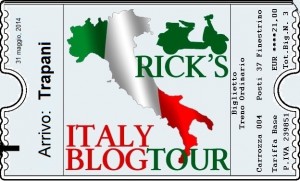 One of the stated goals of my summer blog tour was to find a few of the more unique spots in Italy. Yes, I briefly passed through Milan and Florence, (and of course my homebase in Rome), and they were incredible, as expected. But it’s always a joy to find something unexpected during your travels, and that’s exactly what I discovered along the salt flats of Trapani.
One of the stated goals of my summer blog tour was to find a few of the more unique spots in Italy. Yes, I briefly passed through Milan and Florence, (and of course my homebase in Rome), and they were incredible, as expected. But it’s always a joy to find something unexpected during your travels, and that’s exactly what I discovered along the salt flats of Trapani.
I guess I should clarify a few things. First, I wasn’t exactly in Trapani, per se; I was in Nubia, a nearby village. In fact, we totally skipped the historical center of Trapani during our two-day visit. Not sure if we missed something important, but I don’t care, because our location was peaceful and relaxing, which was exactly what we needed after a full month on the road. Secondly, I said that this place is unique—and it is—but it’s not exactly “undiscovered.” Not that many tourists make it to this part of Sicily, but when they do, almost everybody snaps a quick photo of the windmills on their way to Agrigento from Palermo, for example.
Besides, I’d seen these photos on the Internet, and perhaps you have too. So it wasn’t a huge surprise. But what the photos can’t capture is the overall ambiance created by the colors, the silence, the smell of the sea, the flatness of the terrain, and those salt mills dotting the panorama. Not like anyplace that I’ve ever been before. You really need to settle in for a few days to let it have its effect on you. Which is exactly what we did.
A big part of the uniqueness I can directly attribute to our accommodations, a place called Relais Antiche Saline. Not sure if I’d call it a hotel, resort, or agriturismo. I guess it’s a little of all of those things. In fact, it was originally a working farmhouse, but it was restored into guest quarters in 2006, and now it blends perfectly with the natural landscape. It’s not big, just 18 rooms including 4 “family suites” and one single room. But it holds a special place in the history of this region. I’ll explain more in a bit.
Really it’s a simple place; four-star comfort, but with a family-like feel. We arrived in the middle of a hot, dry afternoon, and it felt like a desert town from an old Western movie. Cactus and tumbleweeds in the gravel parking lot; total silence except for the wind. The sun was almost blinding, reflecting off the water and the white buildings. We quickly unpacked and put on our bathing suits. It’s that type of place, where a bathing suit feels like the most natural thing to wear, even when you’re not in the pool.
One thing to note: there isn’t a full restaurant on the property. Instead, you walk along the salt pools for about 200 meters to the Trattoria del Sale, which is owned by Salvatore Culcasi. Signor Culcasi manages the hotel, too (where he also lives year-round). One of his relatives owns the attached Museo del Sale, so this is really a family business. It was all started by Salvatore’s father, Alberto, who established this relationship between the local tourism office and the museum, which later included the hotel and the restaurant. The sum of this three-way synergy creates a special experience for the visitor, who feels like he has stepped back in time to witness the lives of the salt workers. Actually, your imagination doesn’t have to strain too hard, because the workers are still there today, harvesting the salt in the exact same ancient way.
We learned a lot about the history and traditions regarding salt production in this area during our visit to the museum. Many of the tools used today are exactly the same as they were centuries ago. The use of windmills was something introduced by the Phoenicians, who settled the area around 800 B.C., although these particular saline “only” date back to 1488 when it was constructed under orders from the King of Spain.
The economy of this region has always been tied to the salt, and these days it’s suffering a bit since there are easier ways to make it. And in this era of refrigeration, salt is no longer needed to preserve food. Indeed, the salt flats of Trapani exist today thanks only to the love of tradition by the locals. They use the shallow pools in off season to farm spigola, a popular type of fish for the dinner table, thereby augmenting the income from the salt alone.
Which brings me to the dinner that we enjoyed at the restaurant one night: it was one of the best meals of our entire blog tour. In fact, I’d say that it was THE best “restaurant” meal that we had; the only meals that were better came from the kitchens of our various hosts in Gittana, Paciano, and Palermo. Here at the Trattoria del Sale, their famous salt is used as a crust for cooking fish (the aforementioned spigola). If you eat there, this is the one dish that you simply must try. Surprisingly, it’s not the least bit salty. After removing the layer of crusty salt, the tender meat inside is moist and flavorful—resist the mindless habit of squeezing lemon on it, it’s unnecessary.
This part of Sicily is also known for cous-cous, which I would suggest for a first course. If you prefer pasta, then go for the pesto alla trapanese. And for dessert, the typical choice is a parfait of mandorle (almonds). Light, creamy, and not too sweet.
The area around Nubia is also a natural wonder. In fact, the World Wildlife Fund gives guided tours of the saline, which is a stopping point for flamingoes and other water fowl on their migration routes to and from Africa, drawn to the tasty small crustaceans that live in the salty marshes. In the peak of the summer, the salt itself puts on a show, changing colors as it dries in the sun: first blue, then pink, then yellow, and finally white. This natural process is due to the bacteria that are present at different stages, until the conditions become too harsh (even for bacteria) and they all die off leaving only pure white salt rocks.
Here’s a great site to visit to learn more about the natural beauty of this area.
The triple-treat of the hotel, restaurant, and museum are open all year round. In the off season, it might be enough to just stop for two nights and indulge in this unique landscape and enjoy the local cuisine. During the summer, stay longer, using this as a base to explore Western Sicily, or else just relaxing by the pool and enjoying the silence. In this ever-more globalized information age, it has become difficult to find something unique and unexpected. But thank goodness, it’s not entirely impossible. I found it among the salt flats of Trapani.

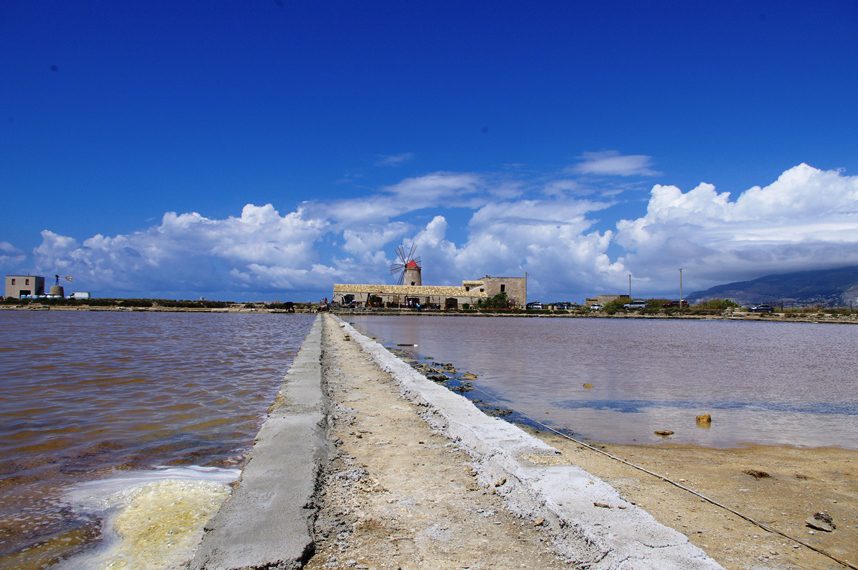
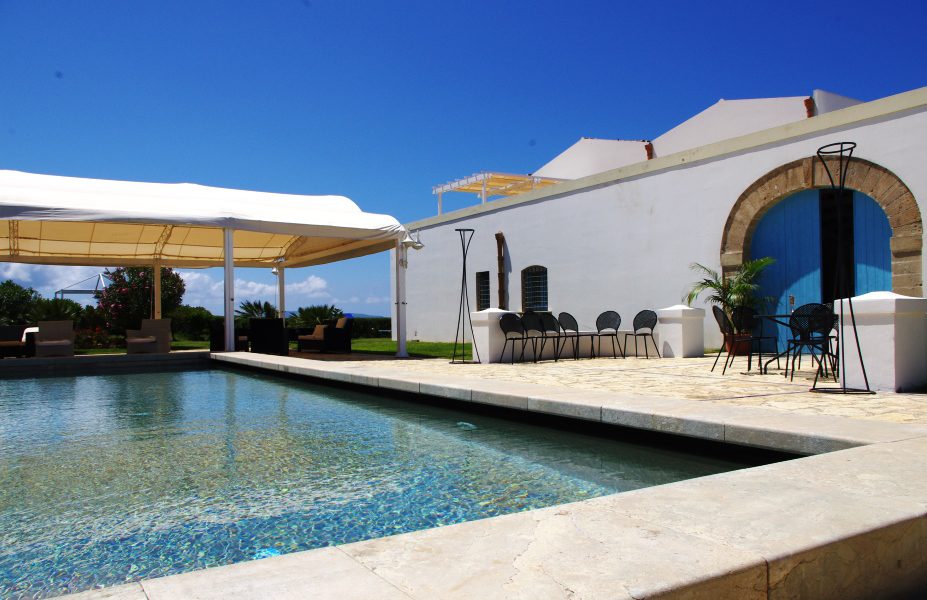
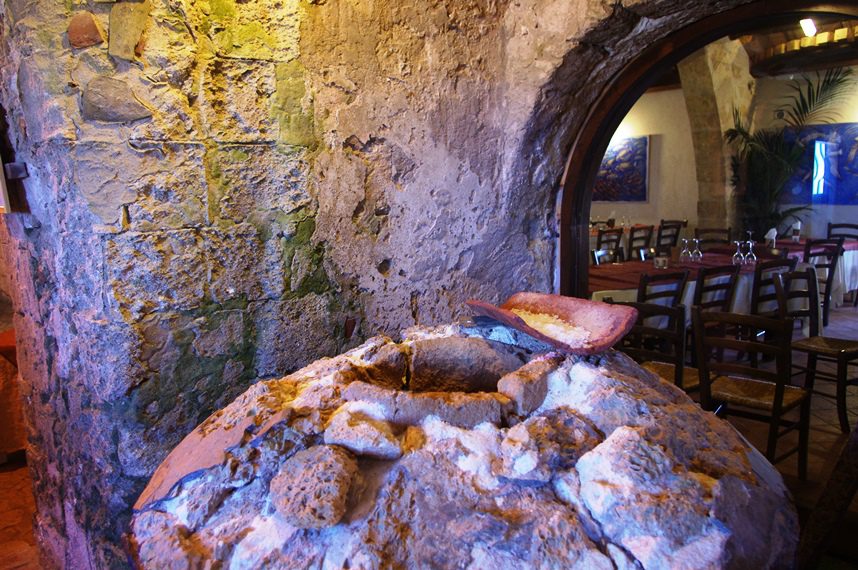
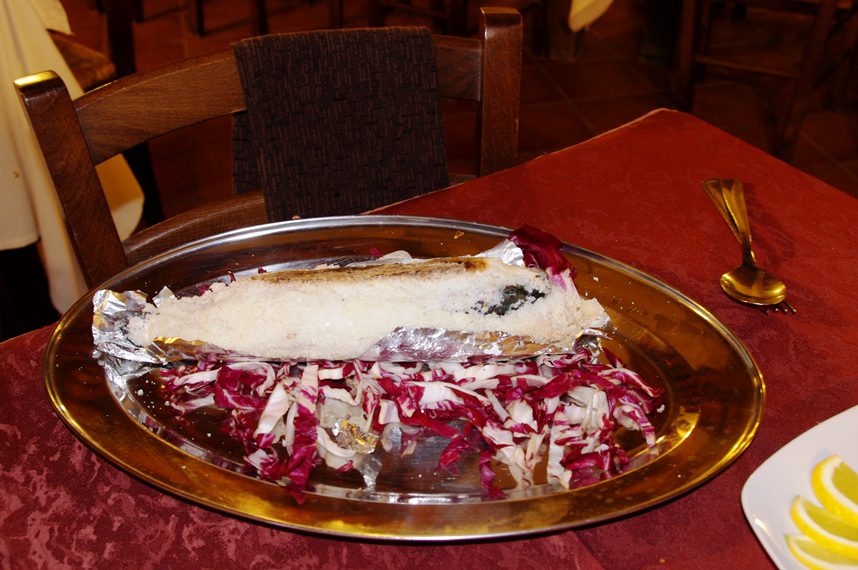
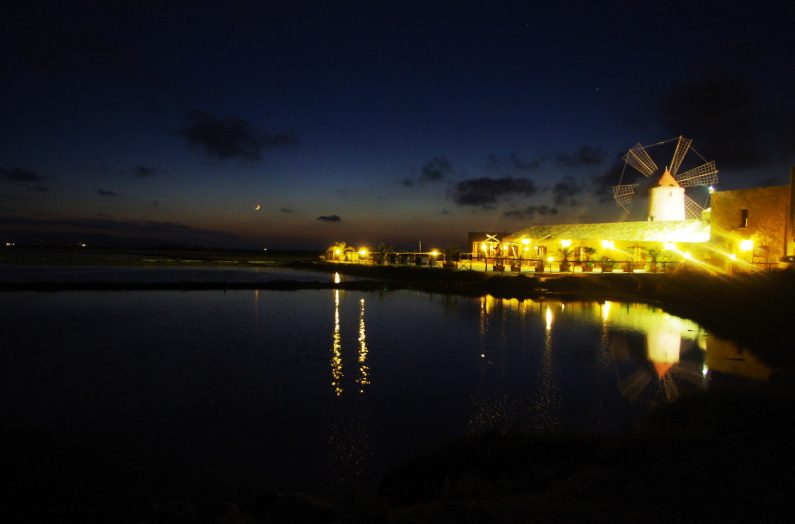

Ciao Rick, I sure wish I had the recipes to some of that meal you described, including dessert! Wow!
Grazie!!
Any advice on reliable tour to Pompeii from Rome without Cameo factory tour etc. added on?
Marcia – Here’s the best way to get from Rome to Pompeii. You can leave Rome early in the morning and be back in Rome by late evening.
How to get from Rome to Pompeii
http://goitaly.about.com/od/rometransportation/qt/rome-sorrento.htm
Go from Roma Termini to Napoli Centrale, then:
Circumvesuviana Trains run between Napoli Centrale (Naples main train station) and Sorrento on the Amalfi Peninsula (see Amalfi map). Circumvesuviana is a private train company.
To get to the Circumvesuviana Garibaldi Station in the Naples train station (Napoli Centrale), go downstairs. Follow the signs! Tickets for these trains (inexpensive) are separate from the Rome to Naples tickets and must be bought at a Circumvesuviana station. There are other stops for this train in Naples.
Train time to Sorrento is one hour, seven minutes. Trains run every half hour (currently leaving Naples at 10 and 40 minutes past the hour starting at 5:10AM with last train at 22:43 and from Sorrento starting at 5:37AM from Sorrento with the last train at 22:25). There may be fewer trains on Sundays or holidays.
Circumvesuviana trains also go to Pompeii, Herculaneum, and Mount Vesuvius. For Pompeii, get off at Pompeii Scavi stop, 36 minutes from Naples. BE SURE YOU GET OFF AT THE POMPEII SCAVI (excavation) STOP! Trains for Herculaneum (Ercalano) and Mount Vesuvius depart several times an hour (don’t take the Sorrento line). For the Ercalano archaeological site, get off at Ercalano Scavi, 17 minutes from Naples. To get to Mount Vesuvius, get off the train at Ercolano station where you can catch a Compagnia Trasporti Vesuviani bus outside the station.
Check the Circumvesuviana web site for current schedules.
Hi Rick. We spent a week in Trapani in 2013. I know some would say it was too long — and since the weather in March was blustery some of our plans did not materialize .BUT, the salt flats, the island of Mozia, nearby Palermo, Segesta, and the INCREDIBLE FOOD made for a great week. The cous cous is to die for. I wish I could find it in Rome, served with the big vat of fish broth. Yum!
Did you meet Peppe Genna, the “craftsman poet of the saltworks?” He’s quite the local character!
Too bad for the blustery weather, but I TOTALLY agree with you! I don’t know why more people don’t go there. Loved it for all the reasons you mentioned, plus it’s just peaceful and relaxing. But NO…I missed out on the craftsman poet…would have been a great separate post for my blog. Anyway, I’m sure I’ll be back..it was one of my favorite stops on my summer tour. Grazie!